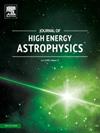重子数密度(n)对奇异星最大质量和稳定性的影响
IF 10.5
4区 物理与天体物理
Q1 ASTRONOMY & ASTROPHYSICS
引用次数: 0
摘要
在奇异物质的MIT包模型状态方程的框架下,给出了具有Vaidya-Tikekar型度量势的各向异性奇异星的爱因斯坦场方程的一类新的相对论解,pr=13(ρ−4B),其中B称为包常数。为了整合夸克核心假说并为物理上可行的恒星模型提供解释,我们通过极端的Wood-Saxon参数化来检查重子数依赖的B (n)。计算了每个重子的能量(EB),将B (n)限制在稳定窗口内,即EB<;930.4MeV (F56e)。本文研究了恒星结构中重子数密度(n)诱导的强子和夸克之间的相变。有趣的是,EB随n变化的性质表明,当n≥1.1fm−3时,每个重子的能量接近恒定值。我们在规定的限制条件下选择n=0.6fm−3,B=66.32MeV/fm3,并考虑4U 1608-52为奇异星候选者。我们发现,对于参数的选择,恒星内部的所有特征性质都得到了很好的满足。TOV方程的数值解得到奇异夸克恒星的最大质量为2.01M⊙,相应的半径为10.96Km。所提出的模型满足必要的能量条件和稳定性标准,证实了其在所使用的参数空间内作为一个现实的恒星模型的可行性。本文章由计算机程序翻译,如有差异,请以英文原文为准。
Effect of baryon number density (n) on the maximum mass and stability of strange stars
A new class of relativistic solutions of Einstein field equations for an anisotropic strange star admitting the Vaidya-Tikekar type metric potential in the framework of MIT bag model equation of state of the strange matter, , where B is termed as bag constant, is presented. In order to integrate the quark core hypothesis and provide an explanation for a physically feasible stellar model, we have examined the baryon number dependent B (n) via an extreme Wood-Saxon, like parameterisation. The energy per baryon has been calculated to restrict B (n) within the stable window, i.e., . This study investigates the baryon number density (n) induced phase transition between hadrons and quarks inside a stellar configuration. Interestingly, the nature of the variation of vs. n, shows that for the energy per baryon approaches a constant value. We choose , within the stipulated restrictions and consider 4U 1608-52 as a strange star candidate. We find that all the characteristic properties are well satisfied within the stellar interior for the choice of parameters. The numerical solution of the TOV equations yields a maximum mass of strange quark stars of and a corresponding radius of . Proposed model meets the necessary energy conditions and also stability criteria, confirming its viability as a realistic stellar model within the parameter space used.
求助全文
通过发布文献求助,成功后即可免费获取论文全文。
去求助
来源期刊

Journal of High Energy Astrophysics
Earth and Planetary Sciences-Space and Planetary Science
CiteScore
9.70
自引率
5.30%
发文量
38
审稿时长
65 days
期刊介绍:
The journal welcomes manuscripts on theoretical models, simulations, and observations of highly energetic astrophysical objects both in our Galaxy and beyond. Among those, black holes at all scales, neutron stars, pulsars and their nebula, binaries, novae and supernovae, their remnants, active galaxies, and clusters are just a few examples. The journal will consider research across the whole electromagnetic spectrum, as well as research using various messengers, such as gravitational waves or neutrinos. Effects of high-energy phenomena on cosmology and star-formation, results from dedicated surveys expanding the knowledge of extreme environments, and astrophysical implications of dark matter are also welcomed topics.
 求助内容:
求助内容: 应助结果提醒方式:
应助结果提醒方式:


